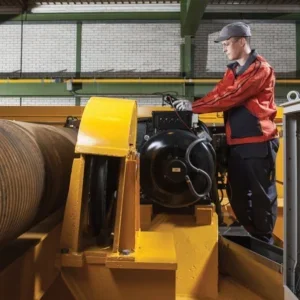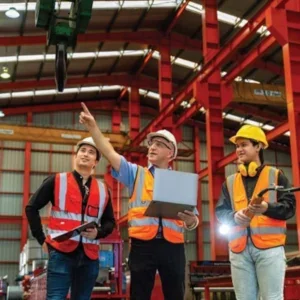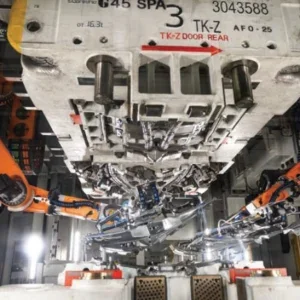If there is one common theme that emerges from western Canadian history and culture, one essential story of Canada in general and the Pacific Northwest and Prairies in particular, it is the story of hardiness and determination in the face of a harsh and unforgiving environment.
So, too, does the western Canadian hoist market persist despite economic headwinds, political challenges, and significant changes in market demands.
Bryan Wescott is the owner of Overhead Crane Solutions, a parts and service provider based in Nisku, Alberta. Wescott says that the Alberta hoist market is in the middle of a slowdown. Although there does appear to be significant market activity in certain areas, Wescott says it is isolated and benefits only a select few companies.
Wescott’s colleague Jim Johnson, president of Overhead Crane Solutions, agrees activity is segmented and marketspecific: “The biggest demand right now is coming from the forestry industry,” Johnson says. “The northern diamond mines that we deal with have been doing well. They’re willing to spend money right now, but they’re mostly investing in modernization.”
Johnson says most demand in western Canada is for parts and service. Most service calls, he notes, involve the minimal amount of repair work needed for the end client to comply with government safety standards.
For Overhead Crane Solutions’ clients, any non-essential repairs are currently on hold.
Pipeline or pipe dream?
The downturn, Johnson and Wescott say, happened in September 2018 when Canada’s Federal Court of Appeal struck down the Trudeau government’s approval of the Trans Mountain oil pipeline. In its decision, the court ruled that the federal government failed to conduct adequate environmental impact assessments and did not fulfil its constitutional obligation to meaningfully consult with Canada’s indigenous people, rendering the government’s prior approval of the pipeline unconstitutional.
According to the Canadian Association of Petroleum Producers, the oil industry accounts for 30% of all economic activity in Alberta. The province of Alberta is landlocked and depends on British Columbia to get oil products to market. Thus, any delay regarding the pipeline expansion is problematic for Alberta’s economy as a whole.
“We noticed a big downturn after the court struck down the approval of the Trans Mountain pipeline,” Johnson says. “We had our eyes set on expanding into a new region of Canada, but as soon as that decision was announced, everything changed overnight.”
The Trans Mountain pipeline is still facing legal challenges. In September 2019, the British Columbia Court of Appeal ordered the provincial government to conduct a new environmental assessment, ruling that the previous environmental assessment is invalid because it was based on the federal government’s original approval report that the Federal Court of Appeal quashed. And in December 2019, First Nations groups filed a new lawsuit against the Canadian Government in the Federal Court of Appeal. This new suit alleges that the second round of indigenous consultations fell short of what the Canadian Constitution requires, and therefore the government’s second approval of the pipeline is invalid. The environmental assessment is ongoing, and while the Federal Court of Appeal dismissed the First Nations lawsuit on February 4, the First Nations are expected to take their case to the Supreme Court of Canada. The First Nations have until April 4 to file an appeal with the Supreme Court.
The pipeline did, however, clear one important legal hurdle on January 16, 2020, when the Supreme Court of Canada dismissed an appeal brought by the Province of British Columbia. Lawyers for the provincial government sought to affirm the province’s right to regulate the kinds of oil products that flow through the pipeline, and aimed to overturn a lower court decision to the contrary. However, the Supreme Court of Canada upheld the previous court decision that regulating the contents of a pipeline falls under federal, not provincial, jurisdiction.
Capitalising on the unexpected
But the pipeline is just one obstacle companies must manoeuvre around. Michael Young is the president of CraneEx, a parts, service, and training company based in Edmonton, Alberta. Young says that fluctuating fuel prices, the federal carbon tax, and unpredictability in international trade are making it difficult to calculate shipping costs.
“The market is changing so quickly that we can’t predict what our costs will be more than two days out,” Young says. “We’re always guessing on how much shipping will cost. The steel and aluminium tariffs coming up from the United States were a disaster for us.
Things change so fast that we’re asking a lot more questions than we should have to, which means it’s getting harder and harder to do business.”
While the oil market is slumping, other industries appear to be doing well. Paper products are in high demand, and CraneEx has done work with several plants that are shipping pulp and paper products overseas.
“We’re selling hoists for mining in Saskatchewan, and that seems to be doing well,” Young notes. “And in Grande Prairie, Alberta, there’s a bit of a natural gas boom happening. Some of the natural gas pipelines around Edmonton are being moved around so that they’ll eventually connect to the natural gas reserve in Vancouver.”
Western Canadian companies are also eagerly investing into new technology, especially safety equipment. The majority of technological upgrades involve a move from wired to wireless pendants.
“There are still a lot of wired systems out there,” Johnson says, “but when people have problems with pendant wires, we find that instead of replacing the wire, they upgrade to a wireless system.”
Wescott says that variable frequency drive hoists are currently in high demand. While service and inspection work tends to be a more active market than manufacturing, there is still demand for fabrication work.
“The market for maintenance is incredibly competitive right now,” Wescott notes. “What we’re seeing right now is that a lot of companies will do what they call an annual inspection, but it’s more of an operational check. We’ve seen our competitors quote for a hoist brake inspection separately from the annual equipment inspection in order to maximise billing. The brake inspection is supposed to be part of the equipment inspection, but that’s where the market is going.”
Despite negative headlines around certain economic sectors, the western Canadian market remains strong, with opportunities coming from unexpected places. Dan Dubrule, president of Meerholz Canada, based in Prince George, British Columbia, says that he’s currently seeing a boom. “From what I’ve heard, we’re supposed to be going into a recession,” Dubrule says.
“But we haven’t seen that. Last year was our best year, and this year is shaping up to be great. Surprisingly enough, one of our biggest sectors last year was sawmills. Sawmills don’t usually have the budget for new purchases, but we’re selling brand new cranes and hoists for sawmill expansions.”
Dubrule notes that Meerholz Canada’s oil and gas customers have been holding steady with purchases. While much of the oil and gas industry is only asking for parts and service, some companies north of Prince George are indeed spending on new equipment.
“It seems like there have been some backburner items that they’re finally deciding to take action on after years of inaction,” Dubrule says.
Meerholz Canada is also seeing strong demand for service work, with the company’s most common service calls involving damaged wire ropes and brake issues for its R&M, Vulcan, and Stahl products. Meerholz’s oil and gas clients are handling all repairs noted on inspection, while sawmills are performing only the most critical repairs. However, certain pockets of the forestry industry are still investing into regular maintenance.
Pulp mills, Dubrule notes, are very active with respect to maintenance work orders. Several companies are also investing into new hardware upgrades that both improve regulatory compliance and optimise work processes.
Says Dubrule: “A lot of our clients are requesting intelligent hoist monitors that can output a signal to a data display or link to a PLC system. These hoist monitors can measure what’s on the hook and then display that information, or perform some other action related to the client’s process.
[Several clients are requesting] the elite controller with upgraded functions instead of the standard controller.”The British Columbia exception
The broader economic trends across other parts of western Canada do not appear to apply to British Columbia, Dubrule says. While national and global trends indicate a large decline in natural resources industries, Meerholz has yet to see any kind of negative impact. In fact, Dubrule says that many Meerholz clients in Prince George and Prince Rupert are now requesting repair work that they had previously delayed. Dubrule credits this resilience to British Columbia’s robust economy: “We do a lot of work in B.C. and the Yukon, and we don’t serve any areas east of Alberta. We hear about doom and gloom elsewhere in Canada, but British Columbia seems to be on its own—it doesn’t follow the Canada-wide trends. We were expecting a big downturn in forestry in regards to new construction, but it hasn’t happened yet.”
Dubrule says that what happens next is anyone’s guess. While Meerholz Canada’s economic outlook for 2020 was negative, Dubrule says the year is off to an incredibly good start—a trend that he hopes continues through the rest of the year.
Prioritising maintenance; Bread-and-Butter Projects
Companies in the eastern Prairies are also seeing steady activity. Mark Logan is the sales and marketing manager for Acculift, a distributor and service provider that designs lift and hoist equipment. Based in Winnipeg, Manitoba, Acculift serves clients across central/western Canada from northern Ontario to British Columbia.
Acculift’s scope of work ranges from a manual-movement workstation crane to a 20t bridge crane.
Logan says that the most common repairs Acculift performs involve replacing worn components on older equipment. Maintenance jobs, he notes, often involve replacing contactors on variable-frequency drives or repairing and replacing chains, wire ropes, and latches. He says that air hoists commonly require more frequent maintenance than electric hoists, meaning air hoists comprise the majority of Acculift’s regular maintenance calls.
“Kito electric-powered chain hoists will run for years with almost no maintenance required,” he says. “Air-powered chain hoists require a lot more maintenance, and depending on the environment, they may require a full cleaning every year.
That would mean taking the entire hoist apart, cleaning it all, and reassembling it. Common replacement parts during this cleaning would be o-rings and vanes.”
With respect to product lines, Logan notes that one of the most popular brands that Acculift carries is the G-Force product line by Gorbel. He says that G-Force hoists are ideal in situations where the hoist operator is doing repetitive or high-precision work. Logan argues that while other brands have attempted to copy the G-Force, none of the imitation products offer the same performance as the original: “The Gorbel G-Force is an intelligent lifting device. You can program it four times faster than other hoists, and you have infinite variable control. It’s also very customisable. We often integrate the control for the hoist unit into the lifting device, so the operator only needs one set of controls to make everything work.”
Logan cites the example of a vacuum suction lift for moving glass. The operator would need controls to operate the suction, to tilt the glass, and to run the hoist. If each control is a separate system in its own housing, operating the lift becomes awkward, slow, and imprecise. When the systems are integrated, though, it’s much easier for the operator to move the load.
“We can incorporate a force-sensing hoist control into the handle of the unit, so if you lift the handle, it brings the load up,” he says.
“The lift can move the load faster or slower depending on how much force you apply to the handle. There’s a large dealership network for construction equipment across Canada, and they’ve been putting these hoists in all their component rooms where they rebuild their engines.”
The key to Resilience: Diversification
Logan says that one of the factors impacting Acculift is the arrest of Huawei CFO Meng Wanzhou. The Royal Canadian Mounted Police arrested Meng at the Vancouver International Airport on December 1, 2018 at the request of the United States government, and the criminal case against Meng is ongoing.
Court documents filed by the United States Department of Justice show that Meng is facing criminal charges in the United States for crimes including bank fraud, in a case related to the country’s economic sanctions against Iran. If convicted, Meng faces up to 30 years in prison for each of the 23 charges against her.
The case has important ramifications for Canada-China relations. Meng was apprehended by Canadian authorities on Canadian soil, and as of press time, she is living under house arrest in Vancouver, Canada pending an extradition hearing.
In retaliation for the arrest, the Chinese government has ordered a halt to imports of Canadian pork and canola products. The trade embargo, Logan says, is problematic for Acculift because of its negative impact on Canada’s agriculture industry, which is one of Acculift’s primary markets.
“As far as the global economy goes, the Huawei arrest is the thing that has hurt us the most,” he says. “But even though agriculture is down, we have other industries that have been picking up the slack. One industry that’s doing well right now is aerospace. We have some aerospace engine rebuilders we work with who have contracts with major airlines, and they bring in engines for scheduled maintenance and rebuilds.”
Logan says that Acculift has also picked up work in the defence industry, which is performing well. While Acculift does not currently work directly with the Canadian Forces, it does sell products and services to companies that manufacture armoured vehicles and other military equipment. In sum, Logan notes, the Canadian hoist market is holding its own in spite of challenges like the fallout of the Huawei arrest.
“The market isn’t up and it isn’t down,” he explains. “Overall, it’s holding steady right now.”
Keith Ellis, general manager for Surrey, B.C.-based Norelco Cranes, agrees. Ellis says that Norelco has had several breadand- butter projects over the course of the last year that have ensured a steady stream of work. For Norelco, these steady projects typically come from clients like sawmills, food processing companies, and wastewater treatment facilities.
“We follow the manufacturing trends,” he says. “If the industry is busy, then we’re busy. When there are new projects in forestry and mining, that’s a boon for us.”
Norelco’s projects most often involve single-girder and double-girder bridge cranes with capacities of 25 tonnes or less. Most often, these cranes are used in general runway systems.
One of Norelco’s most recent breadand- butter jobs involved supplying cranes for a new warehouse. The client, a food processing company in Richmond, was building a new stainless steel freezing building for commercial food applications. “That was a big project,” Ellis notes. “We had 18 10t cranes in the building. We were contracted for all of the runways. That means six 200ft-long bays, and each bay had three cranes.”
Finding bread-and-butter projects in resilient industries appears to be how Canadian companies are weathering the ups and downs associated with political fights over pipelines and sanctions. Whilst the slumping oil and gas market, the onerous steel tariffs, and the agriculture embargo are harming Canadian interests, companies are staying profitable in an inhospitable business environment by doubling down on high-growth subsectors.






